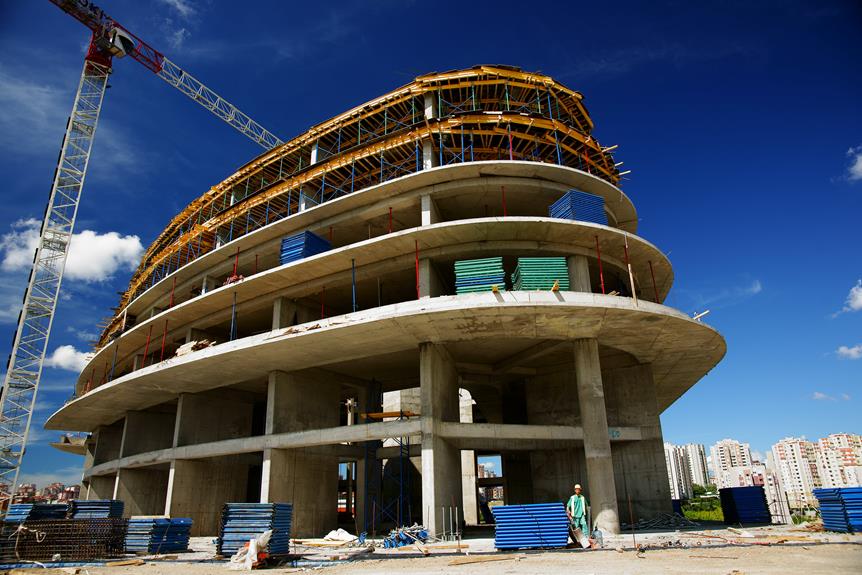Looking to build sustainably without breaking the bank? We’ve got you covered. In this article, we’ll unveil our top 4 picks for budget-friendly sustainable construction materials.
Get ready to imagine a world where recycled concrete, bamboo flooring, salvaged wood, and insulated concrete forms (ICFs) take center stage.
With these materials, you can create a space that not only reduces your carbon footprint but also fosters a sense of belonging to a community that values sustainable living.
Let’s dive in!
Recycled Concrete
We have found that using recycled concrete has proven to be an effective and affordable option for sustainable construction.
The benefits of using recycled concrete in construction are numerous. Firstly, it helps reduce the demand for natural resources such as gravel and sand, which are traditionally used in concrete production. By reusing existing concrete, we can conserve these valuable resources and minimize environmental impact.
Additionally, recycled concrete can be used in innovative ways for sustainable building projects. It can be crushed and used as a base material for roads and pavements, or even as an aggregate in new concrete mixes. This not only reduces waste but also saves money on disposal costs.
Bamboo Flooring
Moving on from recycled concrete, another budget-friendly and sustainable construction material that deserves attention is bamboo flooring. Here are three reasons why bamboo flooring is worth considering for your next project:
- Eco-friendly: Bamboo is a renewable resource that grows much faster than traditional hardwood trees. It can be harvested in just 4-6 years, making it a more sustainable option.
- Durability: Bamboo flooring is highly durable and can withstand heavy foot traffic, making it suitable for both residential and commercial use. It’s also resistant to moisture, making it ideal for areas prone to spills or high humidity.
- Cost-effective: Compared to traditional hardwood options, bamboo flooring is generally more affordable. It provides the same aesthetic appeal and durability at a lower price point.
When it comes to installation, bamboo flooring can be installed using the same techniques as traditional hardwood flooring. However, it’s important to acclimate the bamboo to the environment before installation to prevent warping or buckling.
Salvaged Wood
Continuing on with our exploration of sustainable construction materials, let’s now talk about the benefits of utilizing salvaged wood.
Reclaimed timber, also known as salvaged or upcycled lumber, is an excellent choice for environmentally conscious builders. By repurposing wood from old structures, such as barns or factories, we not only reduce waste but also preserve the natural resources that would have been used to produce new lumber.
Salvaged wood isn’t only eco-friendly but also budget-friendly. It can be found at lower prices compared to new wood, making it an affordable option for construction projects.
Additionally, salvaged wood adds character and a sense of history to any building, giving a unique and timeless appeal.
Good Read: THE DIFFERENCE BETWEEN RECLAIMED AND SALVAGED WOOD.
Insulated Concrete Forms (ICFs)
One of the top picks for budget-friendly sustainable construction materials is the use of insulated concrete forms (ICFs). These forms are made of a combination of foam insulation and concrete, creating a durable and energy-efficient building material.
Advantages:
- Energy efficiency: The foam insulation in ICFs provides excellent thermal resistance, reducing heating and cooling costs.
- Durability: ICFs are resistant to fire, mold, and pests, making them a long-lasting option for construction.
- Noise reduction: The insulation properties of ICFs also help to minimize outside noise, providing a quieter living environment.
Disadvantages:
- Cost: While ICFs can save on energy costs in the long run, the initial cost of using ICFs can be higher than traditional building materials.
- Specialized labor: Proper installation of ICFs requires skilled professionals, which can increase labor costs.
- Limited design options: The use of ICFs may limit the architectural design choices due to the specific requirements of the system.
Despite the disadvantages, insulated concrete forms offer numerous benefits in terms of energy efficiency, durability, and noise reduction. They’re an excellent choice for those seeking sustainable construction materials on a budget.
Conclusion
Ok folks, if you want to save the Earth and your hard-earned cash, these budget-friendly sustainable construction materials are the way to go.
Say goodbye to boring old concrete and hello to recycled concrete, the eco-warrior of building materials. And who needs hardwood floors when you can strut your stuff on trendy bamboo flooring? Don’t forget salvaged wood for that rustic touch.
And finally, insulated concrete forms (ICFs) will keep your home cozy and green.
Go forth, my thrifty environmental warriors, and build sustainably!




